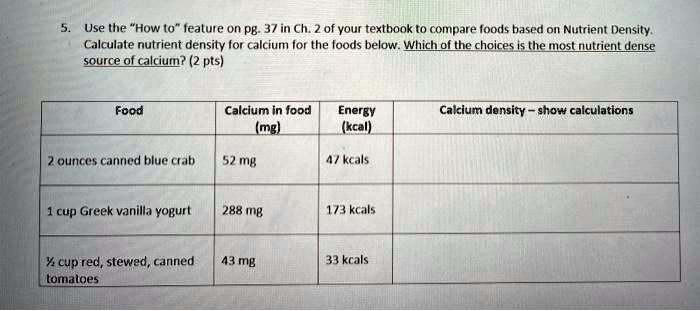In a world where kale smoothies and quinoa bowls often steal the spotlight, understanding the nutrient density of everyday foods is like discovering a hidden superpower in your kitchen. Imagine being able to transform your meals into nutritional powerhouses without the need for exotic ingredients or complex recipes. Whether you’re a seasoned chef or a culinary novice, the art of calculating nutrient density is your ticket to a vibrant, healthier life. Join us on this exciting journey as we unravel the secrets of everyday foods, revealing how the simplest ingredients can pack the most potent nutritional punch. With optimism and curiosity as our guides, let’s dive into the delightful world of nutrient-rich dining, where every bite brings you closer to your health goals.
Unlocking the Secrets of Nutrient Density
Imagine the power of knowing that every bite you take is packed with the maximum nutritional value your body craves. Calculating nutrient density transforms your eating habits by focusing on foods that deliver the most nutrients per calorie. To embark on this journey, start by examining the ratio of essential nutrients such as vitamins, minerals, and protein to the total caloric content of a food item. This method highlights foods that are nutrient-rich yet low in calories, helping you make informed dietary choices.
To effectively evaluate the nutrient density of your meals, consider the following steps:
- Research Nutrient Profiles: Use reliable sources or databases to understand the nutritional breakdown of foods you commonly consume.
- Compare Nutrient Ratios: Identify foods that offer high levels of essential nutrients like fiber, vitamin C, or iron compared to their caloric content.
- Choose Whole Foods: Focus on incorporating unprocessed, whole foods into your diet as they tend to have higher nutrient densities.
- Experiment and Adjust: Track how different foods make you feel and adjust your diet to optimize energy levels and overall health.
By prioritizing nutrient density, you’re not just eating to fill your stomach, but to fuel your life with vitality and wellness.
Everyday Foods with Extraordinary Benefits
Understanding how to calculate nutrient density in the foods we consume daily can unlock a treasure trove of health benefits. Nutrient density is a measure of the amount of essential nutrients a food contains relative to its calorie content. This means that the more vitamins, minerals, and beneficial compounds a food has per calorie, the more nutrient-dense it is. To determine this, you can use a simple formula: divide the amount of a specific nutrient by the number of calories and then multiply by 100. This gives you a nutrient density score, helping you make informed choices about what to eat.
- Fruits and Vegetables: Typically high in vitamins and minerals while low in calories, making them top contenders in nutrient density.
- Whole Grains: Packed with fiber, they offer more nutrients than refined grains.
- Lean Proteins: Such as chicken, fish, and legumes, provide essential amino acids without excess calories.
- Nuts and Seeds: Although calorie-dense, they are rich in healthy fats and micronutrients.
By prioritizing these foods, you can effortlessly boost your nutrient intake while maintaining a balanced diet. So, the next time you plan your meals, think about the nutrient density and aim to fill your plate with foods that offer extraordinary benefits in every bite.
Simple Steps to Nutrient-Rich Choices
Choosing foods that offer the most nutrients per calorie is easier than you might think! By following a few simple guidelines, you can transform your meals into powerhouses of vitamins and minerals. Here are some key considerations to guide your journey towards healthier eating:
- Prioritize Whole Foods: Opt for fresh fruits, vegetables, whole grains, and lean proteins. These foods are typically high in essential nutrients and low in added sugars and unhealthy fats.
- Read Labels Wisely: When choosing packaged foods, look for items with a high nutrient content compared to their calorie count. Ingredients listed first usually make up the largest part of the product, so ensure they are nutrient-dense.
- Embrace Variety: Incorporate a rainbow of colors on your plate. Each hue represents different nutrients and antioxidants that can contribute to your overall health.
Remember, small changes can lead to big results. By consciously selecting foods that pack a nutritional punch, you’re investing in a healthier future, one bite at a time.
Empower Your Plate with Nutrient Knowledge
Imagine a world where every meal you consume not only tantalizes your taste buds but also optimizes your health. This is possible when you become a savvy navigator of nutrient density. To begin, focus on foods that offer the highest nutrients per calorie. By embracing this approach, you can indulge in meals that are both delicious and beneficial.
- Choose Whole Foods: Opt for unprocessed options like fruits, vegetables, whole grains, and lean proteins. These are naturally nutrient-rich.
- Read Labels Wisely: When selecting packaged foods, scan for those with high vitamins and minerals but low in added sugars and unhealthy fats.
- Prioritize Colorful Plates: A variety of colors often indicates a range of nutrients, so aim for a rainbow on your plate.
- Mindful Cooking Methods: Steaming, grilling, and baking can preserve nutrients better than frying or boiling.
By learning to calculate nutrient density, you’re not just feeding your body; you’re nurturing it. Embrace the power of informed choices, and watch as your health and happiness flourish.



